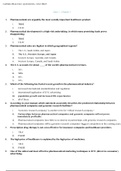Exam (elaborations)
NAPSRx® Exam Question Bank / NAPSRx® Exam Preparation Practice Questions(Verified Answer download to score A)
- Course
- Institution
NAPSRx Exam Question Bank / NAPSR Exam Question Bank (Latest) NAPSRx Exam Preparation Practice Questions / NAPSR Exam Preparation Practice Questions NAPSRx® Exam Question Bank / NAPSRx® Exam Preparation Practice Questions Quiz 1, Chapter 1 1. Pharmaceuticals are arguably the most socially import...
[Show more]



